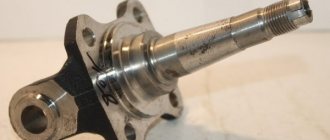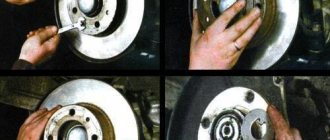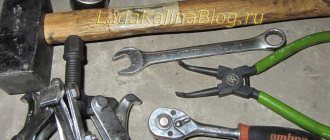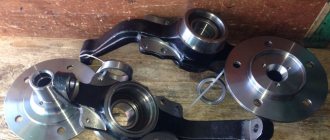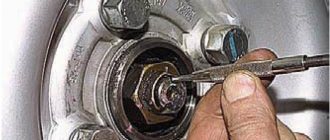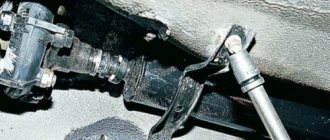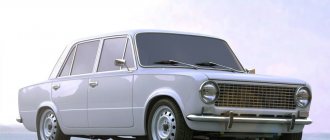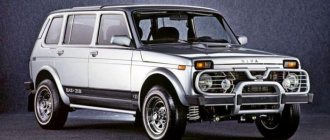To operate a vehicle safely, its wheels must rotate without any problems. If any appear, then nuances arise in driving the vehicle that can lead to an accident. Therefore, the condition of the hubs, axle shafts and their bearings must be periodically monitored, and if problems arise, they must be corrected in a timely manner.
- Steering knuckle
Malfunctions - How to increase wheel turnout
- Table: parameters of VAZ 2106 wheel bearings
Video: checking the wheel bearing on the “six”
- Video: replacing the wheel bearing
- Bearing replacement
Removing the axle shaft
Front hub VAZ 2106
One of the important elements of the VAZ 2106 chassis is the hub. This part allows the wheel to rotate. To do this, a wheel disk is screwed onto the hub, and the rotation itself is carried out thanks to a pair of wheel bearings. The main functions assigned to the hub are:
- connection of the wheel disk with the steering knuckle;
- ensuring a high-quality stopping of the car, since the brake disc is fixed to the hub.
To know how hub malfunctions manifest themselves, as well as how to make repairs, you need to familiarize yourself with the structure of this element. Despite the fact that the part is designed to perform complex functions, it is structurally quite simple. The main parts of the hub are the housing and bearings. The body of the part is cast, made of durable alloy and processed on turning equipment. The hub fails quite rarely. The main malfunction of the product is the wear and tear of the outer bearing races at the installation sites.
The hub secures and rotates the front wheel
Preparing and disassembling the unit
The front rolling bearings are roller, cone type, consisting of two parts: external and internal. Good quality products are sold complete with the required amount of lubricant and two clamping nuts. The nuts differ in their thread, on one it is left-handed, on the other - right-handed, the first will fit the axis of the right axle, the second - to the left.
The manufacturer does not know which wheel will be replaced, so he completes the product with both nuts. Additionally, you need to purchase an oil seal, which is located at the rear of the hub and does not allow grease to leak out. You can carry out the work on a level surface, securing the car with the hand brake so that it does not roll away.
Before lifting the car with a jack, you need to pull out the metal boot covering the hub nut and loosen the latter with a 27 mm wrench. Then the wheel bolts are loosened, the car is jacked up and the wheel is removed. The next step is to remove the brake caliper, which is attached to the axle with 2 bolts; they need to be unscrewed, the part removed and moved to the side.
Caliper
When considering the chassis of the VAZ “six”, you cannot ignore the brake caliper. This unit is mounted on the steering knuckle and holds the brake pads and brake wheel cylinders through appropriate holes, slots and grooves. There is a special hole in the caliper for the brake disc. Structurally, the product is made in the form of a monolithic steel part. When the piston of the working brake cylinder acts on the brake pad, the force is transmitted to the brake disc, which leads to the deceleration and stopping of the car. If the caliper is deformed, which is possible with a strong impact, the brake pads wear unevenly, which significantly reduces their service life.
The “six” caliper is a part without which full braking is impossible
The caliper may receive the following damage:
- appearance of cracks. Since the part is constantly exposed to loads, over time cracks appear on it due to metal fatigue. This indicates the need to replace the caliper, since it is unsuitable for restoration;
- formation of oxides on moving elements. The working cylinders gradually become covered with dirt and an oxide film, and the pistons begin to jam over time, which reduces braking efficiency. In this case, repair or replacement of the cylinders is required.
Replacing an axle shaft or its bearing on a VAZ 2101-VAZ 2107
Welcome! The axle shaft meshes with the gears in the gearbox, thanks to this, when the driveshaft rotates, the gears in the gearbox also begin to move, and the car starts to move. But the axle shaft, like any other part, has its own service life; axle shafts wear out especially badly when they are under heavy load: when you sharply take turns, for example, when you let the rear axle skid, etc. Therefore, take care of the axle shafts: when driving a car carefully, do not make sudden maneuvers - then they will live a long life. Severely worn axle shafts can cause one of the rear wheels of the car to fly out (see photo below), take this into account.
Note! To replace the axle shaft or its bearing, you will need the following: wrenches, a jack, a wrench for loosening the bolts that secure the wheel, and various other keys (socket wrenches, etc.). These tools are needed to remove the axle shaft from the vehicle; To replace the bearing you will also need a grinder, a vice, a new bearing, a new retaining ring and a blowtorch!
Summary:
- How to replace rear axle shafts or their bearings on a VAZ 2101-VAZ 2107?
- Additional video clip
Where are the axle shafts on a car?
The rear axle is an expression understandable to most car enthusiasts; to clarify, let’s say: it is a single whole that includes the gearbox, axle shafts and their housing (see photo below). The arrow in the photo indicates the axle shaft, which comes from the rear axle gearbox and onto which the rear wheel of the car is placed.
When do you need to change axle shafts?
- The axle shafts are replaced if the threads on them are damaged (see photo on the right): the bolts that secure the wheel cannot be tightened and are twisted. The other end of the axle shaft is inserted into the rear axle gearbox (see photo on the left), at the other end there are splines (they are indicated by an arrow), if they come together, the axle shaft will stop rotating altogether, since it will not engage with the gears. Then one wheel will stand still and the other will spin.
- There is another case in which the axle shaft must be replaced - this is wear of the bearing or peeling off of the retaining ring. If the ring has come off its seat, then the rear wheel will have play (by swinging it is easy to understand whether there is this play or not). If there is a problem with the bearing, then noise will appear at one of the rear wheels (play may also be present). For more details about this, watch the video below:
How to replace rear axle shafts or their bearings on a VAZ 2101-VAZ 2107?
Note! In general, it is better not to change the bearing separately, but to buy a new axle shaft assembled with it. You can press the bearing unsuccessfully: drive a few kilometers, and it will fly out of its seat, and the wheel will fly off the car. If you are sure that you will do everything correctly: seat the bearing well in place and check after a while that everything is in order, change the bearing separately. If you keep an eye on it, you can be sure that nothing critical will happen to the axle shaft while driving. And after 2000 km, you can completely forget about it, because if nothing happened during this time, it is already clear that the bearing is properly seated in its place and everything is working!
- At the very beginning of the operation, you need to remove the desired axle shaft or both at once. Even if you do not change them, but only the bearings on them, the axle shafts still need to be removed from the car. For more details on the process of removing the axle shaft from a car, see the article “Replacing axle shaft seals on a classic car.”
Note! When the axle shaft is removed, you need to check whether it needs to be replaced. The first step is to check the threads and splined part on the axle shaft. We have already mentioned where all this is located on it and even showed it in the picture just above. If the threads are not broken and the spline part is intact, move on to the bearing and the retaining ring. First, the bearing: it should sit well, grab it with your hand and move it left and right (as shown by the red arrows in the photo below), it should not move (let's say an axial clearance of 0.7 mm). Next, rotate the bearing: its upper part should spin, but the middle part should stand clearly on the shaft and not move. Otherwise, the bearing is faulty and requires replacement. Now there is a retaining ring (indicated by a blue arrow), thanks to which the bearing stays in its seat and does not move out (if the bearing moves out, the axle shaft will simply fly out of the gearbox), the retaining ring does not perform any other functions. You can tell by eye that the retaining ring has slipped by shaking the bearing, as we said earlier, you can determine one hundred percent whether the retaining ring is seated properly. Sometimes it happens that the axle shaft cracks or bends in some place (usually in the middle part), in this case the axle shaft must be completely replaced!
- When the axle shaft is removed from the car, clamp it in a vice, put on a special suit that is used to work with an angle grinder (it protects the body and eyes from burning chips), and start sawing off the retaining ring. When cutting, do not damage the axle shaft itself so that you do not have to replace it later. Once finished, knock down the bearing with a hammer and some kind of attachment (for example, a chisel) - removal of the old bearing is complete. Next, pick up a new one, if necessary, put more lubricant in it: to do this, use a small screwdriver to pry off the protective cover of the bearing rollers (indicated by an arrow in the small photo), fill it with lubricant, and do the same operation on the other side. Then place the bearing on the axle shaft. The bearing should seat reluctantly; in order for it to fit into its seat, it will have to be hammered in using an adjustable wrench or wrench (see large photo). If this does not happen and the bearing fits onto the axle shaft very easily, then either you selected the bearing of the wrong size, or the axle shaft is already worn out and needs to be replaced. You can’t drive like this, because the axle shaft will fly out immediately, be careful with this.
- What remains is the retaining ring; this is the one you will have to tinker with the most. Take a blowtorch, put a locking ring there, fix it and start heating it. Be careful, because if the retaining ring does not heat up to the required temperatures, it will not seat completely and will have to be cut off and reinstalled. Once heated, use pliers or something else to hook the ring and put it on the axle shaft. It should fall and rest against the bearing (see small photo below). Next, take an adjustable wrench (or wrench) and, as with the bearing, push the retaining ring down until it cools. Only after this can the operation be considered complete and the axle shaft can be installed in the reverse order. Before installation, let the retaining ring cool down, do not rush, otherwise it may come off its seat and the whole operation will have to be repeated from the very beginning.
Additional video clip:
You can see the process of installing bearings and retaining rings on the axle shaft in more detail in one of the videos below. It also tells you how to understand that the bearing has become unusable or the retaining ring has come off its seat.
How to replace bearings
As in the case of diagnostics, we begin the repair by jacking up the car and removing the wheel. Further:
- unscrew the caliper and hang it so that it does not interfere;
- remove the nut cover on the hub;
- unscrew the nut with a 27 wrench;
- remove the washer;
- remove the hub with the attached brake disc;
- remove the small bearing separator;
- remove the oil seal;
- remove the large bearing separator;
- remove the clips with a puller or knock them out with a hammer and chisel;
- remove old grease from the hub and cap.
We perform assembly in reverse order.
- press in the bearing races;
- lubricate and install the inner bearing separator;
- install the oil seal;
- put the hub in place;
- lubricate the outer bearing separator and install it in place;
- install the pressure washer;
- tighten the nut;
- screw the caliper into place.
At this point, the replacement of the front wheel bearing of the VAZ 2107 is completed and all that remains is to adjust the tightening of the nut, this is done as I already described above.
Video on the topic:
Rounded fist
An equally important element of the six's chassis is the steering knuckle. Force is transmitted to it from the steering linkage through the lever, resulting in the rotation of the wheels of the front axle. In addition, ball joints (upper and lower) are attached to the assembly through the corresponding eyes. On the reverse side of the steering knuckle there is an axis on which the hub with bearings is placed. The hub element is fixed to the axle with a nut. The left trunnion uses a nut with a right-hand thread, and the right one uses a left-hand thread. This was done in order to prevent the bearings from being tightened while moving and to avoid overheating and jamming.
Malfunctions
The resource of the steering knuckle is practically unlimited, if you do not take into account the quality of roads and neglect of adjusting the wheel bearings. Sometimes a product can travel 200 thousand km. The part is made of cast iron and can withstand heavy loads. However, if it fails, then the owners of Zhiguli cars often change it along with the bearings and hub
It is necessary to pay attention to the steering knuckle when the following symptoms appear:
- the car began to pull to the sides, and the problem is not eliminated by adjusting the wheel alignment;
- It was noticed that the wheels turned out at a smaller angle. The cause may be problems with both the steering knuckle and the ball joint;
- wheel break. This happens due to the breaking of the threaded part of the steering knuckle or the ball joint pin, which happens relatively often on Zhiguli cars;
- unadjustable play. If the wheel bearings were adjusted untimely or incorrectly, then in the places where they are installed, the steering knuckle axis will gradually wear out, which will lead to the appearance of play, which cannot be eliminated by adjustment.
Sometimes it happens that during car repairs a small crack is discovered on the steering knuckle. Some car enthusiasts advise fixing the problem by welding. However, it must be taken into account that safety directly depends on the condition of the steering knuckle. Therefore, such elements should not be repaired, but replaced with known good ones or new ones.
How to increase wheel turnout
Many owners of the VAZ 2106 and other “classics” are interested in the issue of increasing wheel turnout, since the model in question has a rather large turning radius, which is not always convenient. Those who are seriously involved in tuning their car simply install a set of suspension elements (levers, bipod) with changed parameters. However, such sets for the average owner of a VAZ “Six” may not be affordable, because for such pleasure you will have to pay about 6-8 thousand rubles. Therefore, other more affordable options are being considered, and they exist. You can increase the wheel inversion as follows:
- We place the car on the pit and dismantle the bipod installed on the inside of the hub.
- Since the bipods have different lengths, we cut the longer part in half, remove the part, and then weld it back together.
Installation and adjustment of new parts
The insides of the outer bearing are removed, and the old grease is removed from the opened hole. To get to the insides of the second part, you will need to pull out the oil seal by prying it with a mounting spatula or a powerful flat-head screwdriver. It is recommended to wash the inner surface of the hub together with the remaining clips in it with gasoline or diesel fuel. Sequence of further work.
- Place the hub on 2 wooden boards and attach a punch or other metal rod with a pointed end to the holder from the inside. Lightly tapping with a hammer, knock the part out. During the process, the punch needs to be moved so that the clip comes out evenly. Turn the hub over and perform the same operation on the other side.
- Now you need to study the condition of the surface of the hub seats. If traces of turning the clips are visible, you should think about replacing it. It is possible to somewhat extend the “life” of the hub, for this they use the old antiquated method. Small notches should be made on the surface of the seats with a core or chisel. After pressing the clips, they will sit tightly on these bumps and will not turn for some time.
Hub diagram: 1. Outer ring cage with rollers and inner ring 2. Outer bearing outer race 3. Hub 4. Inner bearing outer race 5. Inner bearing cage with rollers and inner ring 6. Oil seal
- Coat the new clips with a thin layer of thick lubricant, then insert one of them into the hole without distortion. Place an old part of the same size on top and, with light blows of a hammer, press the clip flat into the seat. Repeat the operation on the other side of the hub.
- After carefully lubricating the rollers, place the bearing into the pressed race. You need to start from the inside of the hub. Next, install the oil seal in the same way as described in paragraph 3. Thoroughly lubricate and insert the second bearing; coat both parts generously with thick grease. Wipe both working surfaces of the brake disc from grease and place the hub on the axle axle. Tighten the fastening nut and lightly tighten it with a wrench.
Further assembly is carried out in the reverse order; after completion, the front hub of the VAZ 2106 is tightened with a nut with little force. You can check the correct adjustment by pulling the suspended wheel with your hands on its upper and lower parts.
In this case, a slight play should be felt; the bearing should not be tightened “tight”. After tightening, the nut must be hammered with the sharp part of the hammer, placing it on the side of the nut opposite the groove in the trunnion axis. By hitting it with a second hammer, a depression is made that does not allow the nut to rotate on its own.
When replacing bearings or the entire hub, all internal surfaces should be filled with the thick lubricant that comes with the kit; it should be completely used.
Source
